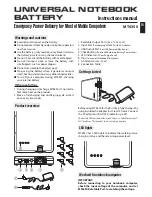
PartitionMagic
Chapter Seven - Software Utilities
106
11.In the lower right corner of the PartitionMagic main window, click Apply.
12.Click Yes to confirm that you want to apply the changes.
13.What happens next depends on whether you have any open files on partitions
being affected by the change.
a. If you have open files, a prompt appears indicating that the changes you
have made require going to MS-DOS mode (if you are using Windows 95
or Window 98) or rebooting (if you are using Windows NT). Click OK to
make the changes. After the changes are made, the computer is rebooted.
If you created a logical partition, the operating system has assigned the
new partition a drive letter.
b. If you do not have open files, the Batch Progress dialog appears, tracking
the following items:
•
Description of current operation
•
Entire process progress bar
•
Sub-process progress bars
If you created a logical partition, after the changes are made, PartitionMagic
displays a message indicating that Windows must restart.
Scenarios
Sample System Configuration
Disk 1 — One 4 GB disk containing:
•
One active primary FAT32 partition (C:) running Windows 95.
•
One extended partition enclosing one logical FAT partition (E:).
Disk 2 — One 2 GB hard disk containing:
•
One 1 GB FAT32 primary partition (D:).
•
1 GB unpartitioned free space.
Procedure
1. Select Disk 2.
2. Create a logical partition in the 1 GB free space using the following
information:
•
Partition Type: Select FAT.
•
Label: Type one, if desired.
•
Size: Accept the pre-calculated size.
Summary of Contents for TransPort NX
Page 10: ...10 ...
Page 18: ...18 ...
Page 42: ...42 ...
Page 52: ...52 ...
Page 60: ...60 ...
Page 128: ...128 ...
Page 134: ...134 ...
Page 150: ...150 ...
Page 152: ...152 ...
Page 156: ...156 ...
Page 170: ...Index 170 Z Zoomed Video 29 ZV 29 Zoomed Video Port 158 ZV Port 164 ZV Port 158 ...
















































